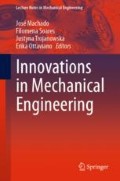Abstract
A large influence on the accuracy and quality of the surface being machined is shown by the temperature processes occurring in the cutting zone at finishing operations, especially such as grinding. Despite a liquid coolant is used to reduce the temperature in a cutting zone, it could become an additional heat source and influence on heating of the grinding machine. To avoid the ingress of heated cutting fluids on the machine parts, devices are used that create an air curtain. The simultaneous effect of flows of cutting fluids and air jets cause a change in heat transfer processes occurring in the cutting zone. The changes of the heat transfer coefficient along the contact line of the grinding wheel and the workpiece are considered in the paper. The phenomenon of overlapping sections of the contact zone of the grinding wheel and the workpiece, that occurs because of the recesses in the coolant under the action of an air jet from both sides is uncovered. It’s determined that the overlap pattern largely depends on the input air pressure and the size of the annular gap between the workpiece and the inner surface of the end elements of the coolant supply device. Construction measures that make it possible to minimize the length of the overlapping sections by air currents are proposed.
Access this chapter
Tax calculation will be finalised at checkout
Purchases are for personal use only
References
Ali, A.Y.S., Awdini, A.O., Adan, H.D.: The effect of globalization on local industries: a case of Mogadishu manufacturers. Int. J. Bus. Manage. Tomorow 2(11), 1–15 (2012)
Otaghvar, M.H., Hahn, B., Werner, H., Omiditabrizi, H., Bähre, D.: Optimization of centerless through-feed grinding using 3D kinematic simulation. In: 12th CIRP Conference on Intelligent Computation in Manufacturing Engineering, vol. 79, pp. 308–312. Gulf of Naples, Italy (2019). https://doi.org/10.1016/j.procir.2019.02.072
Wu, M.F., Chen, H.Y., Chang, T.C., Wu, C.F.: Quality evaluation of internal cylindrical grinding process with multiple quality characteristics for gear products. Int. J. Prod. Res. 57(21), 6687–6701 (2019). https://doi.org/10.1080/00207543.2019.1567951
Kumar, S., Bhatia, O.S.: Review of analysis & optimization of cylindrical grinding process parameters on material removal rate of En15AM steel. J. Mech. Civil Eng. 12(4), 35–43 (2015). https://doi.org/10.9790/1684-12423543
Denkena, B., Grove, T., Göttsching, T.: Grinding with patterned grinding wheels. CIRP J. Manuf. Sci. Technol. 8, 12–21. https://doi.org/10.1016/j.cirpj.2014.10.005
Ozay, C., Ballikaya, H., Savas, V.: Application of the Taguchi method to select the optimum cutting parameters for tangential cylindrical grinding of AISI D3 tool steel. Materiali in Tehnologije 50(1), 81–87 (2016). https://doi.org/10.17222/mit.2014.293
Agarwal, S., Venkateswara Rao, P.: Predictive modeling of force and power based on a new analytical undeformed chip thickness model in ceramic grinding. Int. J. Mach. Tools Manuf. 65, 68–78 (2013). https://doi.org/10.1016/j.ijmachtools.2012.10.006
Aslan, D., Budak, E.: Semi-analytical force model for grinding operations. Procedia CIRP 14, 7–12 (2014). https://doi.org/10.1016/j.procir.2014.03.073
Ropyak, L., Shatskyi, I., Makoviichuk, M.: Analysis of interaction of thin coating with an abrasive using one-dimensional model. Metallofiz. Noveishie Tekhnol. 41(5), 647–654 (2019). https://doi.org/10.15407/mfint.41.05.0647
Vesali, A., Tawakoli, T.: Study on hydrodynamic pressure in grinding contact zone. Considering grinding parameters and grinding wheel specifications. In: 6th CIRP International Conference on High Performance Cutting, pp. 13–18, HPC (2014). https://doi.org/10.1016/j.procir.2014.03.053
Lavisse, B., et al.: The effects of the flow rate and speed of lubricoolant jets on heat transfer in the contact zone when grinding a nitrided steel. J. Manuf. Process. 35, 233–243 (2018). https://doi.org/10.1016/j.jmapro.2018.07.029
Stepanov, M., Ivanova, L., Litovchenko, P., Ivanova, M., Basova, Y.: Model of thermal state of the system of application of coolant in grinding machine. In: Ivanov, V. et al. (eds.) Advances in Design, Simulation and Manuf. DSMIE 2018. Lecture Notes in Mechanical Engineering, pp. 156–165. Springer, Cham (2019). https://doi.org/10.1007/978-3-319-93587-4_17
Strongin, A.S., Nikulin, M.V.: On the issue of calculating air-thermal curtains. In: ABOK, vol. 1 (2004). (In Russian). https://www.abok.ru/for_spec/articles.php?nid=2324
Titov, V.P.: Features of a jet of air curtains. Thermal regime of heating, ventilation, air conditioning and heat and gas supply systems. In: Collection of Papers of MGSU, Moscow, vol. 177, pp. 3–15 (1980). (In Russian)
Stepanov, M., Ivanova, M., Litovchenko, P., Ivanova, L., Kotliar, A.: Improvement of the accuracy of grinding by means of coolant supply. In: Ivanov, V., Trojanowska, J., Pavlenko, I., Zajac, J., Peraković, D. (eds.) Advances in Design, Simulation and Manufacturing III. DSMIE 2020. Lecture Notes in Mechanical Engineering, pp. 325–335. Springer, Cham (2020) https://doi.org/10.1007/978-3-030-50794-7_32
Ryabov, G.K.: Development of technology for the use of gas-saturated cutting fluids in the grinding operations of steel billets. Synopsis of Ph.D. thesis, Kuibyshev (1987). (In Russian)
Banks, R.B., Chandrasekhara, D.V.: Experimental investigation of the penetration of a high velocity gas jet through a liquid surface. J. Fluid Mech. 15(1), 13–34 (1963). https://doi.org/10.1017/s0022112063000021
Cheslak, F.R., Nicholls, J.A., Sichel, M.: Cavities formed on liquid surfaces by impinging gaseous jets. J. Fluid Mech. 36(1), 55–63 (1969). https://doi.org/10.1017/S0022112069001509
Bashta, T.M.: Engineering Hydraulics. Reference Manual. Mashinostroenie, Moscow (1971). (In Russian)
Chugaev, R.R.: Hydraulics (Technical Fluid Mechanics), 4th edn. Energoizdat, Leningrad (1982). (In Russian)
Mordasov, M.M., Savenkov, A.P., Chechetov, K.E.: Method for analyzing the gas jet impinging on a liquid surface. Technical Physics. Russ. J. Appl. Phys. 61(5), 659–668 (2016). https://doi.org/10.1134/s1063784216050170
Author information
Authors and Affiliations
Corresponding author
Editor information
Editors and Affiliations
Rights and permissions
Copyright information
© 2022 The Author(s), under exclusive license to Springer Nature Switzerland AG
About this paper
Cite this paper
Stepanov, M., Ivanova, M., Litovchenko, P., Ivanova, L., Havryliuk, Y. (2022). Study of Heat Transfer Conditions in the Cutting Zone When Grinding. In: Machado, J., Soares, F., Trojanowska, J., Ottaviano, E. (eds) Innovations in Mechanical Engineering. icieng 2021. Lecture Notes in Mechanical Engineering. Springer, Cham. https://doi.org/10.1007/978-3-030-79165-0_17
Download citation
DOI: https://doi.org/10.1007/978-3-030-79165-0_17
Published:
Publisher Name: Springer, Cham
Print ISBN: 978-3-030-79164-3
Online ISBN: 978-3-030-79165-0
eBook Packages: EngineeringEngineering (R0)

